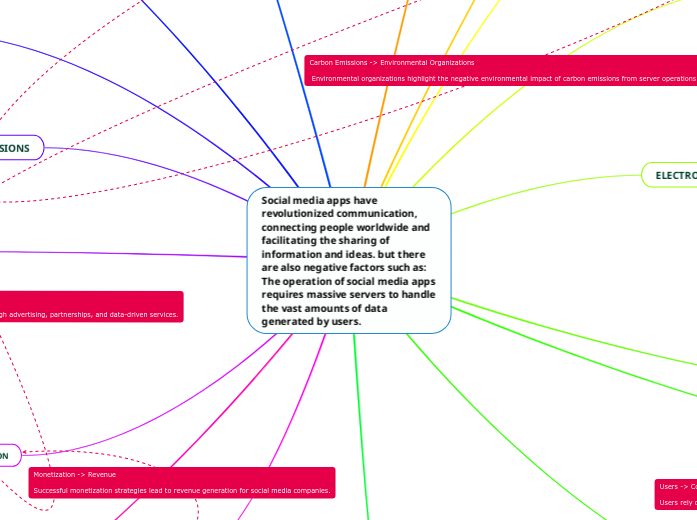Social Media Companies -> Advertising Brands
Social media companies collaborate with advertising brands to monetize their platforms.
Energy Consumption -> Electronic Waste
Increased energy consumption leads to the generation of electronic waste from server infrastructure.
Energy Consumption -> Carbon Emissions
High energy consumption by servers leads to increased carbon emissions, contributing to climate change.
Users -> Semiotics
Users interpret and engage with the semiotics employed by social media apps, such as symbols, signs, and visual cues.
Social Media Companies -> Monetization
Social media companies aim to monetize their platforms through advertising, partnerships, and data-driven services.
Data Centers -> Energy Consumption
Data centers consume substantial energy for server operation, resulting in increased energy consumption.
Carbon Emissions -> Environmental Organizations
Environmental organizations highlight the negative environmental impact of carbon emissions from server operations.
Social Media Companies -> Massive Servers
Social media companies rely on massive servers to host their platforms and store user data.
Environmental Organizations -> Users
Environmental organizations raise awareness among users about the environmental impact of social media app servers.
Social Media Companies -> Data Centers
Social media companies establish data centers to house their massive servers and manage user data.
Electronic Waste -> Environmental Organizations
Environmental organizations advocate for proper management and recycling of electronic waste generated by server operations.
Semiotics -> Social Media Companies
Social media companies strategically design and employ semiotics to engage and retain users on their platforms.
Users -> Social Media Companies
Users provide data, content, and engagement, which are essential for the success of social media companies.
Users -> Environmental Organizations
Users may support and participate in environmental initiatives promoted by organizations concerned about the server's impact.
I am a user as well.
Monetization -> Revenue
Successful monetization strategies lead to revenue generation for social media companies.
Massive Servers -> Users
Users rely on the functioning of massive servers to access and interact with social media apps.
Connectivity -> Technological Advancements
Improved connectivity through social media apps fosters technological advancements in communication and networking.
Technological Advancements -> Social Media Companies
Social media companies benefit from technological advancements, enabling them to enhance their platforms and attract more users.
Users -> Advertising Brands
Users engage with and potentially purchase products or services from advertising brands on social media.
Users -> Connectivity
Users rely on social media apps for connectivity and communication with others.
Revenue -> Social Media Companies
Revenue generated by social media companies sustains their operations and fuels further development and expansion.
Advertising Brands -> Users
Advertising brands target users on social media platforms to promote their products or services.
Massive Servers -> Energy Consumption
Massive servers consume a significant amount of energy to operate, contributing to increased carbon emissions.
Internet Service Providers -> Massive Servers
Internet service providers supply the necessary infrastructure and connectivity for the operation of massive servers.
Social Media Companies -> Internet Service Providers
Social media companies collaborate with internet service providers to ensure efficient data transmission and connectivity.
